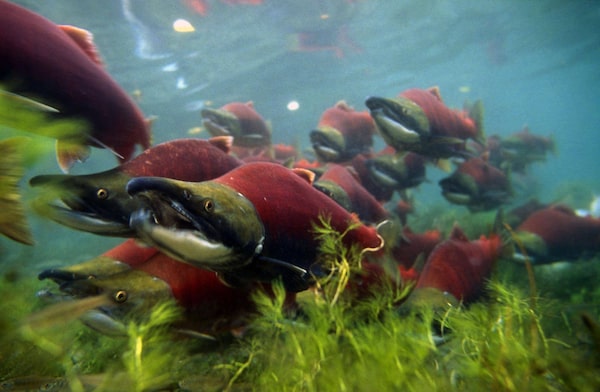
Sockeye salmon.Michel Roggo/The Globe and Mail
For centuries, sockeye salmon have raced up British Columbia's Fraser River to spawn in the millions, completing an astonishing life cycle that spans four years and thousands of kilometres.
Now, scientists have determined that many populations of Fraser River sockeye are in such alarming decline that they should be listed under Canada's Species at Risk Act.
The recommendation, announced Monday by the Committee on the Status of Endangered Wildlife in Canada, an independent scientific body that advises the federal government, is the most significant acknowledgment to date of the jeopardy facing the iconic red-bodied fish that was once the mainstay of British Columbia's salmon industry.
"It's a signal of a larger issue," said Eric Taylor, committee chair and fish ecologist at the University of British Columbia. "The Fraser River is having trouble supporting these fish."
A number of committee members said that, without more decisive government action, long-term prospects for sockeye and other salmon species on the Fraser are grim. Last year saw the lowest number of sockeye salmon returning to the Fraser since records began in 1893.
"The projections aren't great if we don't change the way we do business around the river basin," Dr. Taylor said.
Researchers say a number of factors could be contributing to sockeye decline in the Fraser, including the combined impact of commercial, recreational and traditional fishing, as well as pollution and rising water temperature due to climate change. Warmer water increases stress on the cold-water fish during an exhausting upstream marathon and promotes parasites.
A more controversial question is the degree to which fish farming along the sockeye's maritime migration routes may be transmitting diseases that impact wild fish.
Under the Species at Risk Act, the committee's recommendation must now be taken up for consideration by the federal government. But Ottawa has a track record of failing to list commercially important fish, despite warnings from scientists that failing to do so could lead to population collapses. A recent report by World Wildlife Fund-Canada notes that only 12 of 62 species of Canadian fish deemed at risk of extinction have been listed by the government since 2003.
Emily Giles, a WWF representative who attended the sockeye deliberations last week as an observer, said the state of the sockeye in the Fraser has broad implications for wildlife across the region that depend directly or indirectly on the sockeye as a keystone species.
"They die after they spawn and their bodies go back into the ecosystem and provide important nutrients for the rest of the freshwater habitat," she said.
The Fraser River sockeye assessment was among the most complex tasks the committee has faced in its 40-year history. Work began four years ago and led first to the understanding that 24 distinct populations of sockeye spawn on the river's many tributaries, some of which reach as far inland as the Alberta border. This was an important step, because sockeye are so well adapted to their specific spawning environments that if the species disappeared from one tributary it's unlikely that sockeye from another tributary could be successfully reintroduced there.
Last week, during a marathon session in Ottawa, scientists voted that eight of the 24 populations of Fraser River sockeye should be listed as endangered – representing the highest level of risk that the population could someday be lost. The committee determined that two other populations should be listed as threatened and five more designated "of special concern." The committee also voted that the remaining nine populations of sockeye still occur in large enough numbers on the Fraser that they do not warrant listing.
The diverse assessment sets up the potential for a regulatory headache. As sockeye re-enter the Fraser after years out in the open Pacific, they travel in mixed schools. Because it's not possible to distinguish members of one population from another on sight, a federal listing for some populations would likely require measures to curtail fishing of all Fraser sockeye.
"It's going to be a challenge to implement measures to try to protect these stocks and actually rebuild them," said Alan Sinclair, co-chair of the marine fishes subcommittee, who presented the sockeye data last week.
The committee, which meets twice each year, is set to systematically consider other British Columbia salmon populations in the future, including sockeye in other watersheds as well as coho and chinook salmon.
During a reception last week recognizing the committee's 40 years of service, Catherine McKenna, federal Minister of Environment and Climate Change, said she would adopt targeted timelines for dealing with the backlog of recommendations for listing. The targets include 24 months for terrestrial species and 36 months for some aquatic species including fish.
Experts say this still falls well outside the nine-month maximum that the Species at Risk Act says can transpire between the committee's report on a species and a decision by the government to list the species or not.
"The law is clear," said Amir Attaran, a professor with the Ecojustice Environmental Law Clinic at the University of Ottawa. "Although several governments in a row have pretended – illegally I believe – that they can start the clock only when they want to."
Other recommendations announced by the committee on Monday include delisting the peregrine falcon, which was declared endangered decades ago but which has rebounded since the pesticide DDT was banned. The committee also assessed three populations of grey whales that migrate through Canadian coastal waters. Two of the three, including one that feeds near Vancouver Island, were assessed as endangered.
 Ivan Semeniuk
Ivan Semeniuk